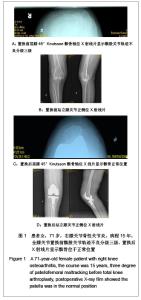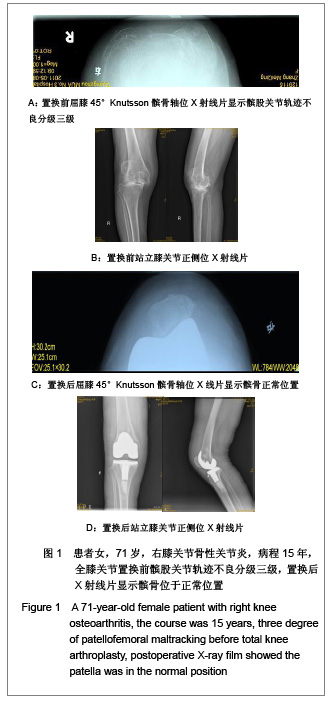| [1] Aaron GR,Joshua JJ,Khaled GS,et al.The patella in revision total knee arthroplasty.J Bone Joint Surg Am.2003;85:63-69.[2] Arnett FC, Edworthy SM, Bloch DA,et al. The American Rheumatism Association 1987 revised criteria for the classification of rheumatoid arthritis. Arthritis Rheum. 1988; 31(3):315-324.[3] Chu XB,Wu HS. Zhongguo Jiaoxing Waike Zazhi. 2004; 12(8): 629-631. 储小兵,吴海山.全膝置换术后髌股关节的运动力学改变及其影响因素[J].中国矫形外科杂志, 2004, 12(8):629-631.[4] Nagamine R, Kondo K, Ikemura S,et al. Distal femoral cut perpendicular to the mechanical axis may induce varus instability in flexion in medial osteoarthritic knees with varus deformity in total knee arthroplasty: a pitfall of the navigation system. J Orthop Sci. 2004;9(6):555-559.[5] Yu ZH,Li YK,Zhao WD,et al. Zhongguo Linchuang Jiepouxue Zazhi. 2007;25(5):489-492,496. 余正红,李义凯,赵卫东,等.伸膝装置应用解剖及其在膝关节置换术中的临床意义[J].中国临床解剖学杂志,2007,25(5): 489-492, 496.[6] Eisenhuth SA, Saleh KJ, Cui Q,et al. Patellofemoral instability after total knee arthroplasty.Clin Orthop Relat Res. 2006;446: 149-160.[7] Endres S, Endres N, Lappas K, et al. Patellar instability. Sportverletz Sportschaden. 2006;20(4):184-191.[8] Barrack RL, Burak C. Patella in total knee arthroplasty. Clin Orthop Relat Res. 2001;(389):62-73.[9] Chu XB,Wu HS,Xu CM,et al. Zhonghua Waike Zazhi. 2006;44 (16):1136-1140. 储小兵,吴海山,徐长明,等.全膝关节置换术中股骨假体旋转对髌股关节生物力学影响的实验研究[J].中华外科杂志,2006, 44 (16): 1136-1140.[10] Lin Y,Qu TB,Wang JJ,et al. Zhonghua Guke Zazhi. 2009; 29 (10):915-919. 林源,曲铁兵,王进军,等.止血带对全膝关节置换术中股骨远端旋转定位时髌骨轨迹的影响[J].中华骨科杂志, 2009,29(10):915-919.[11] Carmont MR, Maffulli N. Medial patellofemoral ligament reconstruction: a new technique. BMC Musculoskelet Disord. 2007;8:22.[12] Sanders TG, Paruchuri NB, Zlatkin MB. MRI of osteochondral defects of the lateral femoral condyle: incidence and pattern of injury after transient lateral dislocation of the patella. AJR Am J Roentgenol. 2006;187(5):1332-1337.[13] Tirveilliot F, Migaud H, Tillie B,et al. Patellar reconstruction during total knee arthroplasty after previous patellectomy. Rev Chir Orthop Reparatrice Appar Mot. 2003;89(7):613-620.[14] Yoshino N, Watanabe N, Kobayashi M,et al. Permanent patellar dislocation due to malunion of supracondylar fracture after total knee arthroplasty. J Orthop Sci. 2006;11(5): 521-523.[15] Bindelglass DF. Rotational alignment of the tibial component in total knee arthroplasty. Orthopedics. 2001;24(11):1049- 1051.[16] Ma HM, Lu YC, Kwok TG,et al. The effect of the design of the femoral component on the conformity of the patellofemoral joint in total knee replacement. J Bone Joint Surg Br. 2007;89 (3):408-412.[17] Nagumo A, Ishibashi Y, Tsuda E,et al. A reversed tibial flip autograft technique for correcting over-valgus knee after high tibial closing-wedge osteotomy in total knee arthroplasty. J Arthroplasty. 2006;21(5):771-774.[18] Dalury DF.Total knee replacement for patellofemoral disease. J Knee Surg. 2005;18(4):274-277.[19] Hsu RW.The management of the patella in total knee arthroplasty. Chang Gung Med J. 2006;29(5):448-457.[20] Benjamin J, Chilvers M. Correcting lateral patellar tilt at the time of total knee arthroplasty can result in overuse of lateral release. J Arthroplasty. 2006;21(6 Suppl 2):121-126.[21] Baldini A, Anderson JA, Cerulli-Mariani P,et al. Patellofemoral evaluation after total knee arthroplasty. Validation of a new weight-bearing axial radiographic view. J Bone Joint Surg Am. 2007;89(8):1810-1817. [22] Incavo SJ, Wild JJ, Coughlin KM, et al. Early revision for component malrotation in total knee arthroplasty. Clin Orthop Relat Res. 2007;458:131-136.[23] Zhang B,Lv HS. Zhonghua Guke Zazhi. 2003; 23(6): 358-360. 张斌,吕厚山.全膝关节置换术中髌骨假体内置的临床研究[J]. 中华骨科杂志, 2003, 23(6): 358-360.[24] Li F,Zhang K,Liu Y,et al. Zhongguo Zuzhi Gongcheng Yanjiu yu Linchuang Kangfu. 2011;15(26):4773-4776. 李锋,张克,刘岩,等.保留髌骨膝关节置换的症状及影像学评价[J]. 中国组织工程研究与临床康复,2011,15(26):4773-4776.[25] Wang XS,Gao ZX,Li JY,et al. Zhongguo Zuzhi Gongcheng Yanjiu yu Linchuang Kangfu. 2008;12(4):752-754. 汪学松,高增鑫,李佳意,等.膝关节置换术中膝外翻的生物力学分析[J].中国组织工程研究与临床康复,2008,12(4):752-754.[26] Koëter S, Diks MJ, Anderson PG,et al. A modified tibial tubercle osteotomy for patellar maltracking: results at two years. J Bone Joint Surg Br. 2007;89(2):180-185.[27] Bicos J, Carofino B, Andersen M,et al. Patellofemoral forces after medial patellofemoral ligament reconstruction: a biomechanical analysis. J Knee Surg. 2006;19(4):317-326.[28] Fulkerson JP. Arthroscopic release of the vastus lateralis tendon for recurrent patellar dislocation. Am J Sports Med. 2006;34(10):1700.[29] Li HM,Dong YH. Linchuang Guke Zazhi. 2006;9(1):86-88. 李海蒙,董英海.全膝关节置换术中髌股轨迹的研究现状[J].临床骨科杂志,2006,9(1):86-88.[30] Pan YQ,Li J,Gao LB,et al. Zhongguo Linchuang Jiepouxue Zazhi. 2009;27(5):595-598. 潘永谦,李健,高梁斌,等.改良Elmslie-Trillat术治疗髌骨不稳定的生物力学与临床研究[J].中国临床解剖学杂志,2009,27(5): 595-598. |

